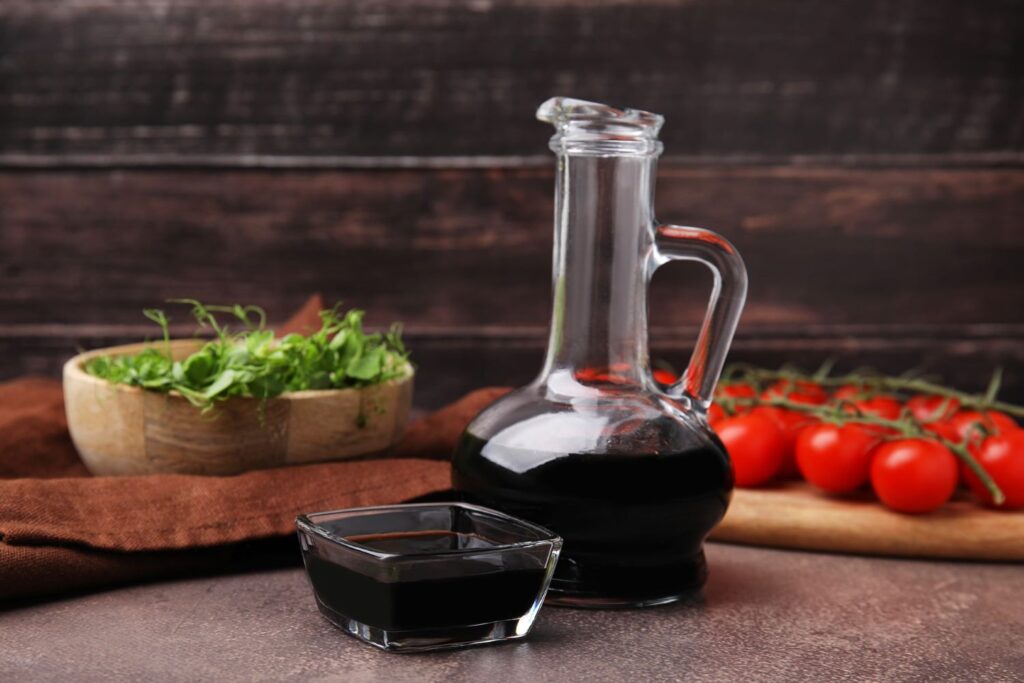The harvest is one of the most awaited moments of the year for many sectors of food and wine prodcution, because the success of this processing phase results in the success of numerous items that end up first on shop shelves and then on tables all over the world. Correct management of the main harvest operations allows you to obtain a high quality product, essential not only for winemaking, but also for the production of fine condiments. A fitting example is given by Trebbiano Modenese, the protagonist grape of “La Vecchia Dispensa”‘s White Condiment, famous for its delicacy and versatility in the kitchen. To make it we do not foresee aging in wood, but only a passage in steel so as not to oxidize its beautiful golden color and alter the organoleptic profile.
Even before the processes we carry out in the vinegar factory, however, there is a series of small attentions that must be paid precisely at the time of the harvest, when the fruit of the dear Modena land lies confidently in our hands. Below we explore with you those best practices to always keep in mind when harvesting hill Trebbiano grapes, with particular attention to the mistakes to avoid to get the most from this variety. We will also provide some useful information on the type of Trebbiano grape, so as to help winemakers and enthusiasts better understand its unique characteristics.
How to Get the Best from a Tasty and Versatile Grape
Trebbiano is one of the most widespread grape varieties in Italy, particularly appreciated for its versatility. In the Modena area it adapts well to the soil, which is of medium texture or heavy, producing a medium-large bunch of elongated conical shape. The grape has a consistent skin of greenish yellow or golden yellow color and this characteristic allows to obtain excellent white wines of straw yellow color with yellow reflections, as well as being used successfully for the production of vinegar.
Trebbiano grape must is also used to create perfectly balanced condiments, such as the White Condiment of “La Vecchia Dispensa”, which stands out for its delicate and slightly sweet flavour, ideal for enriching salads, fish and vegetables.
Useful Tips for Harvesting Trebbiano Grapes
One of the keys to success in harvesting hill Trebbiano grapes is choosing the perfect time for harvesting. These grapes tend to ripen between late August and late September, but the exact time can vary based on factors such as altitude, climate and the vineyards’ exposure to sun. To determine the optimal time, it is essential to monitor the sugar and acidity levels of the grapes. A useful tool is the refractometer, which allows you to measure the quantity of sugars in the must. Excessive maturation could lead to a lowering of acidity, compromising the freshness of the condiment you wish to produce.
When it comes to harvesting, you have to decide whether to use manual or mechanical harvesting methods. Manual harvesting is often preferred for hill grapes, as it allows you to carefully select the best bunches and avoid damaging the fruit. This is particularly important for the production of fine condiments such as White Condiment, where each processing stage affects the final quality of the product. But mechanical harvesting can also be a valid choice, especially if used for large vineyards or where the soil allows the use of machinery without risking damaging the vines or the soil itself.

Mistakes not to be Made when Harvesting Trebbiano Grapes
Even the most experienced winemakers can make mistakes during the harvest. Below we list some of the most common ones, also giving some advice on how to avoid them:
- Harvesting too early or late: as already mentioned, the time of harvest makes the difference between an excellent product and a poor quality one. Early harvests can lead to too acidic grapes, while a late harvest on the contrary risks lowering the acidity excessively.
- Excessive manipulation of the grapes: especially in manual harvests, excessive manipulation of the bunches can damage the grapes and start unwanted oxidative processes.
- Poor cleanliness of tools: Harvesting tools must be cleaned regularly to avoid contamination of the grapes with bacteria or mold.
- Lack of heat protection: Grapes exposed to the sun too long after harvest can suffer heat damage. It is important to transfer the grapes to the cellar as soon as possible.
Are you as Curious as we are to Discover the Fruits of the New Season?
As we have seen, the harvest of Trebbiano Modenese grapes is an operation that requires attention and care. Following recommended practices such as choosing the right time for harvesting and opting for manual harvesting can make the difference in the quality of the final product. In the case of products such as our White Condiment, the quality of the grapes used is essential to obtain a delicate, balanced and versatile condiment. So far we have carefully selected each bunch to bring excellence to our customers’ tables: this year we can’t wait to outdo ourselves with the new production!












![25AF Acetaia_La_Vecchia _Dispensa_Balsamico_Bianco [2]](https://lavecchiadispensa.b-cdn.net/wp-content/uploads/2020/06/25AF-Acetaia_La_Vecchia-_Dispensa_Balsamico_Bianco-2-768x1152.jpg)
![25RF Acetaia_La_Vecchia _Dispensa_Balsamico_Rose [2]](https://lavecchiadispensa.b-cdn.net/wp-content/uploads/2023/04/25RF-Acetaia_La_Vecchia-_Dispensa_Balsamico_Rose-2-768x1152.jpg)





